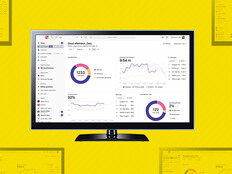Senior citizens are growing more comfortable with modern technology. A 2019 Pew Research Center study finds that 85 percent of baby boomers use the internet. Among those ages 74 to 91, nearly two-thirds are going online — with Facebook usage nearly doubling since 2015.
The increasing number of plugged-in older Americans is prompting senior living residences to upgrade their wireless LANs and other IT infrastructure to support the many devices that require bandwidth to operate, whether a tool is being used in a person’s room or anywhere else on the property.
Some centers also are adding residential tech support to help with tasks such as connecting laptops and tablets to the WLAN or mastering Skype to converse with loved ones. Others are going a step further by deploying tools that include virtual reality, touch screens, wearables and gaming platforms.
Designed to improve seniors’ quality of life, these evolving technologies share a common thread: a need for strong infrastructure.
Such upgrades, after all, are often market differentiators for potential residents and their adult children, says Chip Burns, CIO of Sun Health Communities, which operates three locations for nearly 1,000 residents in the Phoenix area.
“These new seniors want to know that we are on top of technology — even if they’re not,” says Burns. “Their families want to know that mom and dad are going to a place where they will not only have the technology themselves but the family can keep in touch too.”
As younger populations age, those capabilities one day will be standard offerings, not perks, according to “The 21st Century Senior Living Community,” a 2017 CDW white paper. Scalable network solutions, it notes, help nurture a fully functioning tech ecosystem and shift outdated views of assisted living.
Some residences are assessing those needs not only for the present but also to anticipate what expanded capabilities might be required in the future.
INSIDER EXCLUSIVE: Watch a CDW Bring IT On session about connecting seniors and technology.
Wi-Fi 6 Delivers Enhanced Networking Capabilities
To best serve seniors using personal devices, WLAN coverage must blanket every part of a residence, not just common areas, says John Couture, vice president of IT for Lifespace Communities. The Des Moines, Iowa-based company operates 15 retirement communities in eight states.
“Having wide Wi-Fi coverage has become expected as opposed to being nice to have,” Couture says.
A recent infrastructure upgrade at Lifespace Communities is supporting initiatives that include virtual reality (one location in Pennsylvania is crafting two VR rooms that will allow visitors to experience life with Alzheimer’s disease), digital screens to convey updated news to residents, videoconferencing tools for staff and a tablet distribution program.
An emerging option to help support this growing stable is Wi-Fi 6 — which, despite higher costs and complexities, is poised to offer users greater speed and security.
“It doubles the bandwidth, increases client capacity and lowers latency,” says Ritesh Patel, a Dell’Oro Group analyst. “Wi-Fi 6 will enable a better end-user experience for residents as well as staff.”
That, Couture notes, is already under consideration. “Having the latest Wi-Fi standard that can support more devices per node will be essential to support growth.”
Faster Wi-Fi also triggers upgrades to the broadband connections that operators get from their local telecom providers — a necessary boost for senior residences as wireless devices become more prevalent in use and quantity among those who live there.
“Right now, we’re putting a 100-megabit-per-second pipe into each community,” Burns, of Sun Health, says, adding that the work is far from complete. “We think we need to get 10 times that within the next five years.”
MORE FROM HEALTHTECH: Find out how to use tech to attract and retain senior care staff.
New Networks and IT Infrastructure Enable Emerging Tech
In 2018, Sun Health turned to CDW for a major infrastructure overhaul that included Aruba Networks switches, wireless routers and access points; Dell servers; HPE Nimble Storage flash arrays; and VMware commercial desktop visualization products.
It all helps support a variety of offerings that include computer classes, VR headsets and interactive screens for gaming and therapeutic purposes. “We are working to keep seniors connected socially, both on and off the campus, and provide them options for technologies that will help us help them enjoy life to the fullest,” Burns says.
The new infrastructure also provides a foundation for an expansion of Sun Health’s La Loma Village residence in Litchfield Park, Ariz.
“We want to create smart ‘casitas,’ where, at the construction stage, we embed certain types of technologies,” Burns says. One example: smart speakers throughout each home that residents can use to control lighting and HVAC systems, set personal reminders and even request specific community-based services.
“We will be creating customized Alexa skills,” Burns says. “You can ask for transportation or a plumbing work order, those kinds of things.”
The La Loma expansion will include an innovation center within its community center to garner insights and feedback from visitors. Increasingly, Burns says, newcomers anticipate “a certain level of technology and expect that we can help support them.”
“Residents and members of the community can come in and look at the types of technologies that are on the horizon for us,” he adds. “They also can use existing ones and try things out.”
READ MORE: Learn how providers are building networks to meet requirements today, tomorrow and beyond.
Network Tech Upgrades Support Staff and Data Security
Having the latest technologies in senior living residences also helps attract and retain an engaged workforce. And reliable Wi-Fi is critical for team members using mobile devices for daily applications that range from electronic health records to sales and dining services.
“Our employees are coming in expecting to have some kind of tech,” says Chris Guay, president and CEO of Vitality Senior Living. Guay intends for Vitality’s wireless platforms to be buildable and adaptable for two decades.
The Brentwood, Tenn.-based operator has 14 communities across the Southeast, with another six under development, and serves 875 seniors. “Think about asking a nurse who recently graduated from a program that is all electronic to manually enter a note or a medication log,” Guay says. “They will look at you like you’re crazy.”
The proliferation of Internet of Things devices is another major factor driving many residences to upgrade their networks. IoT tools, which can monitor everything from a patient’s vital signs to building temperature, typically use little bandwidth.
But they mark a big security concern: IoT traffic needs virtual LAN separation to help protect HIPAA-regulated data.
“The footprint of the IoT devices is increasing the number of entry points — and potential vulnerabilities — for hackers and unauthorized users,” says Couture, of Lifespace Communities. “Ensuring that these entry points are secure and segregated from the business network is a must from a security perspective.”










